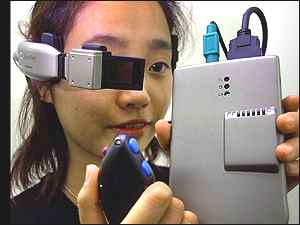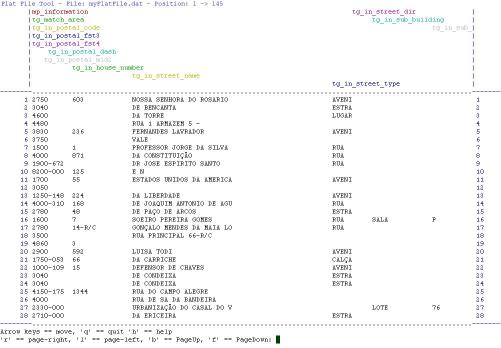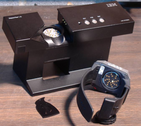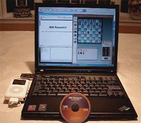
Highlights from 8 years at IBM:
- 35 articles demonstrating new technologies
- 13 patents from RFID to cloud management
- 14 IBM Thanks peer recognition awards
- IBM Thinkplace Innovator Award
- 38 IBM Bravo/Ovation awards
- IBM Bravo award for technical achievement
- 19 Invention achievement awards, 5 patent plateau awards
- Selection to the Early Career Conference
My first opportunity with IBM came as a Co-Op through R.I.T with the
Personal Computing Division Executive Briefing Center in Research
Triangle Park. This was a fantastic opportunity where I helped
administer PC's and Laptops representing all of IBM's consumer grade
hardware. In addition to technical support, I had the opportunity to
demonstrate the Wearable PC to customers. (Photo credit: BBC), more
coverage at the
BBC and IBM Research. This was a great working experience
with David Laubscher, Jeff Walls, Doug Baldwin and many others.
After the co-op and graduation from R.I.T. I began work with IBM as a
full time 'regular' employee with Global Services. I worked closely with
Andrew Levandoski doing Java programming. Among other projects, I worked
on adding multi-threaded support to a data processing application.
As part of the Customer Database team, I helped manage the batch
processing data identification, matching and cleansing systems. This
role focused on managing the Trillium software system on
AIX

Managing tens of gigabytes of customer data in a flat
file format with the existing tools was inadequate, so I created the
'Flat File Tool', which is useful for managing and visualizing large
plain text files with no line delimiters. You can read more about the
fftool program at [SourceForge](http://fftool.sourceforge.net/)

After a few months at IBM, I began work on an instant
messaging client using the
Sametime SDK. I wanted many of the features
available in other clients, but IBM's internal feature release schedule
was not as fast as expected. I used my experiences with Windows
Application development in college and at TM Technology to create
Sametime Plus. As of March 2009, it still has features not available in
the internal IBM Sametime client.
There was a distinct need for a hardware and software environment local
to our administrators instead of in [Ehningen,
Germany](https://www.google.com/maps/place/IBM+Ehningen/@48.6502964,8.9364503,2062m/data=!3m1!1e3!4m8!1m2!2m1!1sibm+ehningen+data+center!3m4!1s0x0000000000000000:0x3b35d9ef4bbf614c!8m2!3d48.6519571!4d8.9467496). I created some
specifications and acquired IBM-surplus AIX "medium-big iron" for faster
processing of data. This project involved the setup of
[7017-S80](http://www.coworthtechnologies.com/products/ibm/system-p/rs-6000/ibm-rs-6000-s80)'s and
terabytes of storage in a raised floor data center environment.
Setting up systems, applications and database connections with the data
quality analysis team gave me unique exposure to IBM's internal customer
data. Beyond the challenges of duplication, entity relationship
modelling and analysis methods, there were significant data quality
issues. I worked with Enya Garcia and Alex Jankowsky to address many of
these data quality issues. We created business rules, worked with the
data custodians for each geography, and created actionable reports and a
web application. IBM'ers worldwide could fix their own mis-entering of
data, from typographical errors to business rule violations and
placeholder entries. Moreover, violations could be tracked from an
individual to mid management and corporate head level, leading to much
greater visibility of data quality issues.
Visualizing terabytes of data can be a significant challenge. To address
some of these issues I used surplus systems to create a minimalist
'display wall' of 9 monitors. This led to the beginnings of many IBM
[developerWorks articles](http://www.ibm.com/developerworks/opensource/library?sort_by=&show_abstract=true&show_all=&search_flag=&contentarea_by=All+Zones&search_by=nathan+harrington&topic_by=-1&industry_by=-1&type_by=All+Types&ibm-search=Search).
Various steps in the [Trillium](https://www.trilliumsoftware.com/) Batch process respond well to simple
parallelization, as their is no shared data between the records. I used
surplus systems gathered from the data center environment and custom
Perl scripts to automatically divide the processed data amongst servers.
Each server would run the parser process on its data, and send the
information back to the central processing server. This simple approach
reduced the processing time linearly - the more servers you add the
faster the overall process.
An organization as large as IBM exposes the employee to a wide variety
of bureaucratic and logistic issues. I worked on various projects in the
data center to address these needs. Mapping the locations of people
within buildings and creating automatic reporting structure graphs were
created for the broader IBM community.

In addition to world class consumer grade hardware and
software, IBM has access to some of the worlds most interesting device
prototypes. I contacted IBM Research and asked for access to the
WatchPad prototype. [M. T.
Raghunath](https://in.linkedin.com/in/m-t-raghunath-a98600) and
[Chandrasekhar
Narayanaswami](http://researcher.watson.ibm.com/researcher/view.php?person=us-chandras) were a fantastic help getting
me up and running with the IBM WatchPad environment. Working with this
hardware was a unique learning experience, which you can read more about
on the WatchPad page. I also had experience with the IBM [Tetra](http://archive.linuxgizmos.com/device-profile-cdl-paron-secure-pda/) smart
phone, which included a fingerprint reader and lightweight Linux
environment.

After working on the IBM WatchPad, Chandra approached me to
consider helping out with the IBM SoulPad. This was another great
opportunity to work on a Linux software stack that represented the
leading edge of virtualization. you can read more about my experiences
with this project on the SoulPad page.
Exposure with management through the success of these and other projects
led to my involvement with a wide variety of groups within IBM. Among
these were the EBI Innovation Team, Autonomic Technology Cohorts, NC
Green Team, and the IGS Invention Development team.

Addressing a sales idea from Derrick Brown
led to the Resource Locator project, and the many successes and awards
it produced for the Resource Locator team.

Expanding on the procedural and technical success
of the Resource Locator project was the goal of the BlueBerry enterprise
data search application. Click the link above for further details
including what a 120+ laptop processing cluster looks like.
During this time I also worked as a System Administrator for the Central
Customer Master System project. In this role I configured and
administered dozens of systems in diverse geographical locations for a
multi-national team supporting test and development efforts across
multiple platforms. I also did a little J2EE development to support
features in various releases for the project.
Over the past three years, I have written 38 IBM developerWorks
articles, completed patent applications for innovations in 19 different
areas, and participated in multiple podcast interviews with Scott
Laningham. You can read more about these projects and their associated
Awards and Recognition from IBM.
The successes within IBM described above and on other pages led me to
begin the "Innovation that Matters - for your career and your bank
account" talk to various organizations within IBM. This presentation was
unique in that it would be more than someone just reading slides to you.
I'd go through the pages of the Presentation, and tailor the spoken
component to the audience. Using some of the tools described on these
pages, I would give specific examples of innovation for the organization
and individuals of that organization based on the corporate goals and
personal skill sets of the listeners.